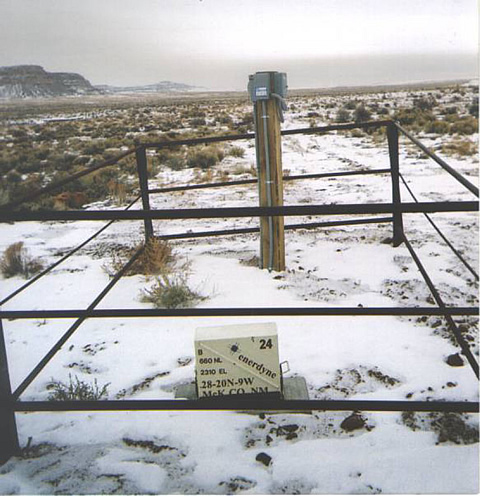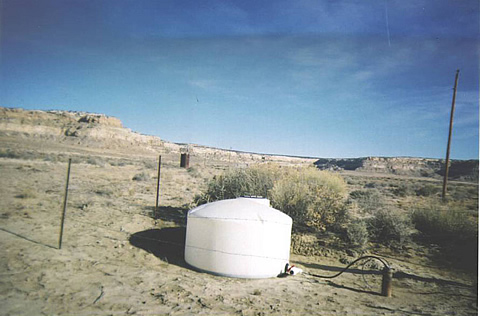A joint venture between Enerdyne LLC, a small independent oil and gas producer, and Pumping Solutions Inc., developer of a low-volume electric submersible pump suspended from a cable-both based in Albuquerque, NM-sought to reestablish marginal oil production from Red Mountain oilfield by working over 17 existing wells, installing submersible pumps, and operating the field for approximately one year.
Project Results
Enerdyne has reached the conclusion that the cable-suspended pumping system, when installed in a shallow reservoir such as Red Mountain oilfield, can be a more cost-effective artificial-lift method than the conventional rod pump method. It thus can provide an operator the opportunity to extend the life of a similar field by reducing the man-hours to maintain pumping wells and by lowering operating energy costs.
Since this diaphragm type, positive displacement hydraulic submersible pump system eliminates the need for expensive surface pumping equipment that requires constant maintenance, pumping labor costs can be reduced by 60%. This, coupled with the reduced operations electricity cost savings of about 45%, creates a significant comparative cost advantage that can extend the economic life of a marginal oil well.
However, at the end of about one year of operating the submersible pumps to produce Red Mountain oilfield, 3 of the 16 pumps installed had failed due to electrical complications.
In summary, in spite of the pump failures, the submersible pumping system was found to have several advantageous features:
- The system was able to pump acid, solids, and fine sand without failure.
- The pump was able to pump off without pump failure.
- The system could be installed or removed in one third the time required by conventional methods.
- The pump can be tied into rigid or flexible tubing.
- The system eliminates costly surface equipment with many moving parts.
- The system can be operated with solar power and therefore is applicable in remote locations.
- The system operates for about half the energy cost to operate a conventional surface-mounted electric motor.
- The system can reduce pumper man-hours.
- The system surface equipment is more aesthetically pleasing.
Conversely, the system can cause a unique set of potential problems during operations:
- The system can not be maneuvered in the wellbore with flexible tubing.
- Differential stretch of the system components can cause the suspension cable to cut into or pinch off the flexible tubing during production.
- The pulsating action of the pump can cause the suspension cable, the tubing, or the electrical supply line to wear against the well casing.
- The pump is susceptible to failure from numerous electrical conditions on the surface and downhole.
- Field personnel must be educated about the system in order to prevent damage during installation or replacement.
- Special field equipment is required to install or remove the system cost-effectively.
Benefits
There are a tremendous number of stripper oil and gas wells producing in the United States, many coalbed natural gas wells that require dewatering, deviated wells that are impossible to produce with conventional rod systems, and chemically challenged wells where the downhole environment can significantly reduce the life of conventional steel pumps, tubing, and rods. All of these wells are capital-intensive to equip. With a diaphragm type submersible pump system, costly surface equipment can be eliminated, and operating cost can be reduced. In doing so, that investment can be directed toward exploration rather than production, which adds reserves and creates jobs.
Where producing wells are located within urban areas that are sensitive to air and noise pollution, the submersible pumping system appears to be the solution to both the community and the producer in an aesthetically pleasing manner.
Project Summary
In April 2003 a cooperative 50% cost-share agreement between Enerdyne LLC and DOE was executed to investigate the feasibility of using cable-suspended electric submersible pumps to reduce lifting costs and increase ultimate oil recovery in Red Mountain oilfield, located on the Chaco Slope of the San Juan Basin. The field was discovered in 1934 and has produced 350,000 barrels of oil. Prior to April 2003, the field was producing only about 20-30 barrels per month; however, reservoir characteristics suggested that the field contains ample oil for production to be economically revived. The shallow nature of the water-drive reservoir, where oil occurs with fresh water at depths of 290-1,000 feet, served as a relatively good test area.
Seventeen well bores were selected by Enerdyne for workover. Wells were selected based on their completed depth and casing size (4-inch inside diameter) to accommodate the pump.
Using Enerdyne's rig, conventional methods were employed to clean out all wells of sediment. Each well then was treated for minor skin damage and circulated. No significant problems were incurred during these procedures. After each well was cleaned, the submersible pumping system was installed via a special coiled tubing trailer. With the exception of one installation, all pumps were eventually installed and tied into a temporary power supply and storage tank. The one installation that was not completed was the result of an unforeseen downhole condition that caused the pump to become stuck diagonally in the well and irretrievable. It was found that when using a cable to suspend the pump and flexible production tubing, the movement of the pump is extremely limited within the wellbore. Several other pumps had to be pulled and reinstalled because of electrical or chemical problems.
Following the temporary tie-in procedures, each well was pumped until it was determined that the well was stable and reservoir conditions were normalized. The well was then pumped for a period of time to gauge the produced fluid and determine the actual oil cut. It was concluded that, on average, a well would produce about 8 barrels per day of fluid with a 15% oil cut.
In summary, the project has:
- Returned Red Mountain oilfield to marginal oil production.
- Evaluated the cable-suspended electric submersible pump system in comparison with the conventional rod-pump system.
- Determined the economic and social benefits of a submersible pumping system.
Phase III of the project calls for additional drilling to improve field economics. Based on 3-D seismic, eight well locations have been staked and three permitted to drill by the State. All locations target fluvial sandstones in the Mesaverde Menefee formation, ranging from 1,050 feet to 1,750 feet in depth. Potential-reserve calculations estimated 2.5 million barrels of original-oil-in-place.






